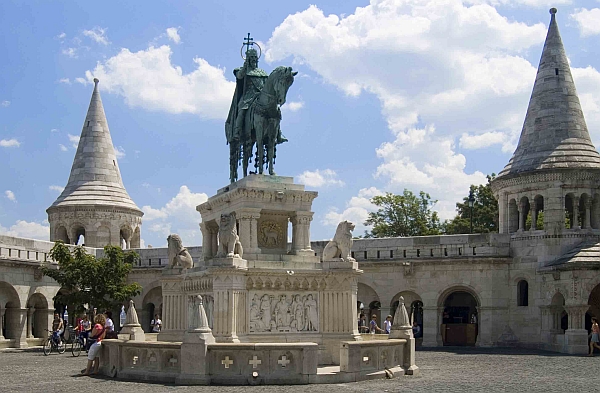Name: The castle district
Category: Architecture, castles and historic districts
Location: 1014 Budapest, Szent György tér
Description
After strolling around the castle walls and enjoying the views or visiting a museum, why not enjoy the delights of wandering through the old part, where you can stop here and there to look at a shop window, a façade, a monument, to capture it on your video or in a photo. If you are hungry or thirsty, just stop one of at one of the stalls or the bars along the street and you will be spoilt for choice.

The Castle District
The Castle District in Buda Erected in the 14th century and rebuilt in the Baroque style 400 years later, the royal palace at Szent György tér was the residence of the Hungarian monarchs for 700 years.
Today it houses Budapest’s most frequented museums and galleries. The Hungarian National Gallery (Buildings B, C, and D) offers a selection of the history of arts in Hungary from the 10th century to the present day. Exhibits include a collection of early medieval and Renaissance stone works, Gothic wood-carvings, panels and triptychs, Renaissance and Baroque art, 19th- and 20th-century painting, sculpture and collections of coins and medals. Guided tours are available to the crypt of the Hapsburg viceroys.
At the History of Budapest Museum (Building E) restored sections of the medieval royal palace in Buda, its chapel and Gothic sculptures as well as permanent and temporary exhibitions on Budapest’s history can be seen.
The National Széchényi Library (Building F), the country’s largest library, houses – among others – a rich collection of the Corvinas, medieval codices from King Matthias’ library.
In Building A the Museum of Contemporary Arts, also known as the Ludwig Museum, displays the works of outstanding Hungarian and foreign contemporary artists.
Topped by a tower of stone tracery, Matthias Church, also called the Church of the Blessed Virgin Mary, (2 Szentháromság tér) was the scene of coronations and royal weddings. In the early 19th century it was rebuilt in a neo-Gothic style. Its crypt now displays a collection of ecclesiastical artefacts. From spring to autumn concerts are organised here.
The Fishermen’s Bastion, a neo- Romanesque bulwark with seven towers built on medieval walls, offers an excellent view of the city. Further back the remains of the 13th-15th-century St. Nicholas Church with a Dominican monastery have been ingeniously incorporated into the interior of the stylish Hilton Hotel. The Dominican courtyard of the hotel hosts open-air performances.
The urban middle-class houses in the streets connecting Bécsi kapu tér and Dísz tér, gates to the Castle District, were built on medieval foundations. The Gothic sedilia of their doorways lend a unique feature to them. The Castle Cave, a 1,800-m section of the 12-km cave system under Castle Hill (entrance at 16 Országház utca) is open to the public only by booking in advance.
The Military History Museum (40 Tóth Árpád sétány) displays memories of Hungary’s military past, and the medieval Jewish Chapel (26 Táncsics M. utca) offers an insight into the past life of the Jews in Buda.
The Baroque Erdődy- Hatvany Mansion (7 Táncsics M. utca) keeps rare musical instruments from the Museum of Musical History as well as a rich collection of the manuscripts of the great Hungarian composer Béla Bartók (1881-1945).
Good to know about the castle district
- The Buda Castle District dates back to the 13th century when King Bela IV built a castle here after the devastating Mongol attacks of 1242
- The medieval town of Buda grew around the castle; the town’s real development started when the Royal Court moved here in the 15th century
- Under the rule of King Matthias (1458-90), Buda became one of Europe’s most powerful cities
- The Turks occupied the castle in 1541 and ruled it until 1686 when the Habsburgs and their allies took it back; the siege devastated both the casle and the town
- After the Turks left and the Habsburgs moved in reconstructions began; the area became a government district; the current Baroque appearance was finalized by mid 18th c.
- World War II devastated the area once again; reconstructions recreated the Habsburg appereance
- The Royal Palace houses the Hungarian National Gallery and the Budapest History Museum. The building’s grand design is the master work of local architects
- Another major site is Sandor Palace; the official residence of the Hungarian president
- The district is a Unesco World Heritage Site
Did you like The castle district? Please share your opinion below or rate it at the top!
Have you got any Budapest or The castle district related question? Please have a look at our Questions & Answers section!
Take a look at the Menu “Attractions” on our new Budapest Guide to see what other tourist sights are around in the capital of Hungary.
The castle district on the map
Click for Google Route Planner here.
Share this article with others
There is an easy way how to link to our Budapest guide & maps about The castle district, ready to use on your website. Simply copy & paste the HTML code below into your page source code. Thank you for all links to Budapest travel guide!